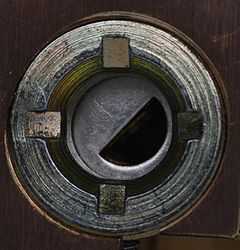Abloy Classic: Difference between revisions
m (Templating) |
No edit summary |
||
| Line 30: | Line 30: | ||
File:Abloy_Classic_keys.jpg | File:Abloy_Classic_keys.jpg | ||
File:Abloy_Classic_sidebar.jpg|The Classic sidebar. | File:Abloy_Classic_sidebar.jpg|The Classic sidebar. | ||
File: | File:Abloy_Classic_sidebar_misaligned.jpg|The sidebar improperly aligned. | ||
File:Abloy_Classic_sidebar_aligned.jpg|The sidebar properly aligned. | File:Abloy_Classic_sidebar_aligned.jpg|The sidebar properly aligned. | ||
</gallery></div> | </gallery></div> | ||
| Line 59: | Line 59: | ||
<div align="center"><gallery> | <div align="center"><gallery> | ||
File:Abloy_Classic_discs_all.jpg|A complete set of discs from an Abloy Classic. | File:Abloy_Classic_discs_all.jpg|A complete set of discs from an Abloy Classic. | ||
File:Abloy_Classic_disc_stack.jpg|Classic discs and false gates. | |||
</gallery></div> | </gallery></div> | ||
Revision as of 18:38, 9 September 2009
Abloy Classic
| Abloy Classic | |
 | |
| Name | Abloy Classic |
|---|---|
| Manufacturer | Abloy |
| Lock Type | Cylinder |
| Lock Design | Disc-detainer |
| Year(s) Produced | 1907 - Present |
| Related Locks | |
| Abloy Profile Abloy Disklock Abloy Executive Abloy Protec | |
The Abloy Classic is a disc-detainer lock made by Abloy. The Classic uses between 5 and 11 discs that interface with a sidebar. Designed in 1907 by Emil Henriksson, it is distinguished as being the first disc-detainer lock design. Classic models are easily identified because they use a half circle ("D" shape) keyway. The Classic has since been superseded by many other models, the latest of which is the Abloy Protec.
Principles of operation
|
|
Abloy literature refers to the plug as the "cylinder" and the cylinder as the "housing". Lockwiki uses the traditional terms to avoid confusion. |
The Classic works by using angled bitting cuts on the key to properly rotate discs. The key is inserted and rotated 90°; the angled cuts on the key in rotate the discs in the lock. If all the discs are rotated to the correct position the sidebar can fall into the true gates and the plug can be rotated. Washers are placed between discs to ensure that the key rotates each disc individually.
There are six positions available for discs, at 18° increments between 0° and 90°. In an eleven disc lock, there are 362,797,056 (611) theoretical key differs.
Discs provide manipulation resistance in the form of false gates. In addition, they may use a modified cut-out shape to deter the use of improperly shaped tools.[1] The first disc in the lock is made of hardened steel and is free-floating. This provides drill resistance as well as lockpicking resistance.
The cut-out shape of each disc is also used to control the keyway profile of the key are various points. The cut-out of the first (steel) disc controls the keyway profile along the entire length of the blade, but individual discs can have modified shapes to change the warding in the center and back of the lock.
Notes
- The first disc (hardened steel) is always a 1 cut (90°).
- Master keying is made possible by multiple true gates cut on each disc.
- The sidebar may be round (round true gates) or L shaped (square true gates). Modern Abloy designs all use the L shaped locking bar.
Disassembly instructions
Disassembly of the Abloy Classic is fairly simple, though care must be taken to ensure the discs, washers, and sidebar are removed properly. Discs cannot be flipped around and the order of washers must be preserved to ensure proper function once reassembled.
Padlocks
Note: The shackle must first be released via a key or other method of entry to non-destructively disassemble Abloy padlocks.
- Unlock the lock and release the shackle.
- With an allen wrench, unscrew the cylinder retaining screw (Hole on the side, near the bottom. Releasing the shackle clears this area.)
- Lock the shackle and remove the key.
- With the bow end of the key, unscrew and remove the cylinder faceplate.
- Remove the plug and sidebar. Holding the disc stack with a key is recommended.
Cam locks
- Remove the cam.
- With a flathead screwdriver, remove the C-clip by lightly tapping counter clockwise.
- Remove the plug and sidebar from the back of the cylinder.
Vulnerabilities
The Classic may be vulnerable to one or more of the following:
Notes
- If a round sidebar is used the front of the cylinder can be drilled and sidebar removed to unlock the lock.
Gallery
References
- ↑ Fey, Han. 2004. Discs make the difference.





